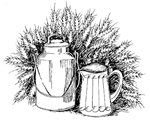What is Oxygen Radical Absorption Capacity (ORAC)?
 In recent years ORAC ratings have begun to appear on a number of food and supplement products. In this article we will explain what ORAC is and what it is telling you about the product.
In recent years ORAC ratings have begun to appear on a number of food and supplement products. In this article we will explain what ORAC is and what it is telling you about the product.
ORAC means Oxygen Radical Absorption Capacity. It is a measurement of the antioxidant capacity of food. Antioxidants are substances that control the activity of oxygen free radicals. Oxygen free radicals are formed when electrons associated with one oxygen atom leave that atom and join the electrons of another oxygen atom. This causes the molecules containing the atoms to become unstable and act as free radicals. For an in-depth discussion of free radicals and their causes, go to: http://www.milkandhoneyhealthfoods.com/the-healthy-cell-concept-part-three.
While production of oxygen free radicals is a normal biological process that serves many useful purposes, this process can get out of hand and be destructive to the body. To keep this process in check, the body uses antioxidants. Many foods have been analyzed by ORAC testing to determine their antioxidant capacity.
This testing is done by mixing a class of free radicals called peroxyls with various known antioxidants found in foods. Measurements are then taken and ratings are assigned to show the effectiveness of these antioxidants against the peroxyl free radicals. Peroxyl radicals are the most common free radicals and are known to damage fatty acids, proteins and DNA in the body.
Peroxyl radicals, however, are just one of several classes of free radicals that cause damage to the body. The hydroxyl free radical is very reactive and can damage carbohydrates, nucleic acids, lipids, and amino acids. This free radical is created in the skin by exposure to ultraviolet rays from the sun. The peroxynitrite free radical is very damaging to proteins. It has been shown to degrade collagen protein which is a major protein found throughout the body. Superoxide anion is an extremely reactive free radical that damages fatty acids and DNA. Lastly, the singlet oxygen free radical has been shown to oxidize LDL cholesterol and is therefore a factor in the development of cardiovascular disease.
Some labs are now using tests to identify antioxidant activity for all five of the classes of free radicals discussed above. In so doing they have been able to identify a wider spectrum of antioxidant activity associated with specific substances that in the past were measured only for their peroxyl fighting ability. This broader assessment of antioxidant capacity is called Total ORAC. Total ORAC is broken down into tests such as ORAC for peroxyls, HORAC for hydroxyls, NORAC for peroxynitrites, SORAC for superoxide anion and SOAC for singlet oxygen.
For example, the antioxidant resveratrol has been found to have much greater activity against singlet oxygen and peroxynitrite free radicals than against peroxyls. The antioxidant astaxanthin works to neutralize singlet oxygen free radicals but does little against peroxyl free radicals.
Identifying greater antioxidant capacity in substances previously measured only for their ability to neutralize peroxyl free radicals has opened the door for the production of more targeted antioxidant supplements. Antioxidant supplements are now appearing in the market place that feature specific groupings of antioxidants targeted to specific health problems. For example, someone with heart disease may want to take an antioxidant supplement that features a high amount of astaxanthin which fights singlet oxygen free radicals. As discussed above, singlet oxygen free radicals are known to oxidize LDL cholesterol which can lead to atherosclerosis.
The company Nature’s Plus recently introduced a group of products called “AgeLoss.” These products provide a blend of antioxidants in each formula that is targeted to specific health problems. For example, their product for liver support has a total ORAC rating of a little over 3000.
654 is ORAC (capacity to fight peroxyls)
1181 is HORAC (capacity to fight hydroxyls)
36 is NORAC (capacity to fight peroxynitrites)
1144 is SORAC (capacity to fight superoxide anion)
215 is SOAC (capacity to fight singlet oxygen)
Since it has been determined that hydroxyls and superoxide anions are more associated with the liver than the other free radicals discussed above, more antioxidants are included in the liver support product to fight these particular free radicals. This is the approach used in all 23 different products that are included in the “AgeLoss” formulas.
In conclusion, it should be noted that eating a daily diet high in a variety of fruits and vegetables will provide a wide range of antioxidants. If you are unable to eat such a diet, using a high quality green food concentrate such a BarleyLife will provide the variety of antioxidants the body needs. If you are experiencing specific health problems associated with your heart, liver, lungs, prostate kidneys, etc., you may find the AgeLoss line of products of great benefit.